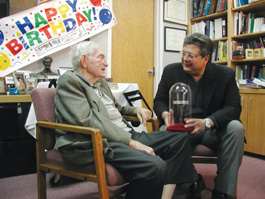home | metro silicon valley index | movies | current reviews | film review

The Original Long Hairs: The late Ira F. Brilliant (left) and Dr. Alfredo Guevara talk follicles for 'Beethoven's Hair.'
Mane Event
The ultimate 'hair-loom' is traced from Beethoven's head to SJSU in documentary at San Jose Jewish Film Festival
By Richard von Busack
FOR those who are Top 100 chart watchers, this news will be no surprise: it turns out it was metal that killed Beethoven. Based on Russell Martin's book, Larry Weinstein's documentary Beethoven's Hair shows how a single lock of the deathless composer's mane had almost two centuries' worth of adventures.
Snipped by Beethoven's dear friend, a small capsule of the hair was passed on from father to son. Against Weinstein's expertly montaged footage of World War II, we learn that the hair was still there, biding its time in an obscure Danish fishing village. It ended up in the hands of a pair of collectors, who in turn donated the keepsake to an institution the end titles of Beethoven's Hair describe as "the University of San Jose." More accurately, the hair is now apparent at the Ira F. Brilliant Center for Beethoven Studies at San Jose State University.
Beethoven's Hair screens Oct. 28 as a benefit gala (with regular-price showings on Oct. 29 at Camera 12) at the library for the San Jose Jewish Film Festival. The evening will include wine, food, song, a free copy of Martin's book and a guest appearance by Martin and Weinstein—as well as a look at the fabled snippet of Ludwig Van Beethoven's hair.
Beethoven's end was horrific—swollen with fluids, the composer expired over a course of months. The day after the composer's demise, on March 26, 1827, his friend Ferdinand Hiller took a lock of Beethoven's hair as a keepsake. Hiller was a minor composer and the friend of many renowned musicians of the 1800s. Before his death, he passed the hair on to his son.
Through circumstances, the lock was transferred to two collectors in the American Southwest: the folksy Nogales-based urologist Dr. Alfredo Guevara and the late Ira F. Brilliant of Phoenix.
The two men were similar only in their Schroederesque love of Beethoven. Brilliant, who drove a Lexus with the vanity plates "L Van B," started a fine collection of Beethoveniana in his closet. Guevara's awe for his hero is more laid-back. He's seen hosting an Arizona-style birthday party for Beethoven, complete with tequila shots and a mariachi band.
Weinstein observes the replica of the Brussels "Mannekin-Pis" fountain in the courtyard of Guevara's clinic, a pretty good advertisement for an urologist's service. While conducting some sort of minor operation on a patient, the doctor notes that the aftercare requires two six-packs of Moosehead lager—one for the patient to use as a cold compress, the other to drink.
Guevara thought that a definitive cause of Beethoven's death might be determined by analysis of the composer's hair. A postmortem at the University of Arizona in 1995 began the process. Finally, a hair from Beethoven's head took another journey, this time to the particle accelerator at the Argonne National Laboratory in Illinois. There, the cause of Beethoven's illnesses—and perhaps his legendary temper and his deafness—were analyzed; and there it was determined that slow environmental poisoning was the culprit.
Beethoven's Hair is part Antiques Roadshow, part CSI, part Nova and part The World at War. It is a tribute to Weinstein's economy and concentration—as well as the passions of 200 years of Beethoven lovers—that the story is so coherent. The archival work here is superior. Weinstein not only located some uncommon images of World War II but also revived images from some of the many Beethoven movies made, including Abel Gance's 1936 biopic and Walter Kolm-Veltee's 1949 Eroica.
The documentary footage of Dr. Josef Goebbels opening a German concert hall to the "Ode to Joy" chorale might have once given Stanley Kubrick the idea to accompany Alec the Droog's torture with that particular music in A Clockwork Orange. Among other things, the documentary retrieves Beethoven's legacy from the Nazis' perverted embrace of romantic music.
The idea of the presence of a great heart surviving in the form of a tiny lock of hair is more than touching. If the documentary has two tiny flaws, it's that it makes the keeping of a lock of hair seem so novel. A quick background on the custom might have been welcome, since this hair-keeping isn't done so much anymore.
To a modern audience, you practically have to translate Groucho's requesting a lock of Margaret Dumont's hair. ("You're getting off easy. I was going to ask for the whole wig.") Women of the 1800s sometimes made braided jewelry or charms out of the hair of their dead children or husbands. And at the Bancroft Library in Berkeley, there's a lock of Mark Twain's silver hair waiting for the fond gaze of his fans.
The other matter—Weinstein might have thought of this as a visual distraction—is that, though Beethoven's death was squalid, his passing wasn't solitary; a crowd of 30,000 waited to bury him. And as we see here, the mourning for Beethoven has never ceased.
![]() Beethoven's Hair shows as part of a special evening Oct. 28 at 6:30pm at Martin Luther King Jr. Library; tickets are $125. The film also shows Oct. 29 at 5:30 and 7:45pm at Camera 12. The festival runs through Nov. 19; see www.sjjff.org for details.
Beethoven's Hair shows as part of a special evening Oct. 28 at 6:30pm at Martin Luther King Jr. Library; tickets are $125. The film also shows Oct. 29 at 5:30 and 7:45pm at Camera 12. The festival runs through Nov. 19; see www.sjjff.org for details.
Send a letter to the editor about this story.
|
|
|
|
|
|